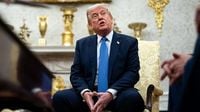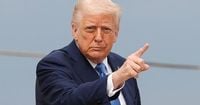On May 9, 2025, President Donald Trump made a significant announcement at the White House regarding U.S. trade policy, stating that the country will maintain a minimum tariff of 10% on its trade partners. However, he quickly added that exceptions could be made if a partner country takes extraordinary actions for the benefit of the United States. This nuanced approach reflects the complexities of U.S. trade negotiations and the potential for flexibility in future agreements.
During his remarks, Trump emphasized, "There will always be a base tariff. But we can also make exceptions. At some point, a partner will do something extraordinary for the U.S. That can always happen. Basically, the minimum tariff is 10%, and some countries will face much higher rates." This statement comes on the heels of a trade agreement reached with the United Kingdom, which became the first nation to formalize a deal with the U.S. following the announcement of reciprocal tariffs by Trump in early April.
Despite the agreement with the UK, the 10% tariff on British imports will remain in effect, illustrating the administration's commitment to this baseline rate. White House Press Secretary Karoline Leavitt reinforced this position, stating, "President Trump is determined to use a base tariff rate of 10%. He just spoke to me about that." This steadfast approach aims to address the ongoing trade deficit and bolster domestic production.
However, Trump's later comments hinted at a willingness to negotiate more flexibly, which could lead to mixed signals for U.S. trading partners. As the administration engages in multiple trade negotiations simultaneously, clarity and consistency in messaging will be crucial. Reporters at the White House questioned Trump about the upcoming discussions with Chinese officials, aimed at reducing the high tariffs imposed by both nations on each other's goods.
Earlier on the same day, Trump used social media to suggest a possible reduction of tariffs on Chinese goods from a staggering 145% to 80%. When pressed for details about the lowest tariff he is willing to impose on Chinese imports, Trump indicated he had a threshold in mind but declined to confirm whether it was 80% or lower. He stated, "We will see how the negotiations go." This uncertainty adds another layer of complexity to the U.S.-China trade relationship, which has been fraught with tension.
The implications of Trump's tariff policy extend beyond bilateral relations with the UK and China. As the U.S. navigates its trade landscape, the administration's approach to tariffs will likely influence negotiations with other countries as well. The potential for exceptions to the minimum tariff could encourage nations to engage in more significant negotiations, while simultaneously creating apprehension about the unpredictability of U.S. trade policy.
In summary, President Trump's reaffirmation of a 10% minimum tariff, coupled with the possibility of exceptions for extraordinary actions, sets the stage for a dynamic and potentially contentious series of trade negotiations. As the U.S. continues to engage with its trading partners, the outcomes of these discussions will be closely watched, particularly in light of the ongoing economic challenges and the need for a balanced trade approach.





